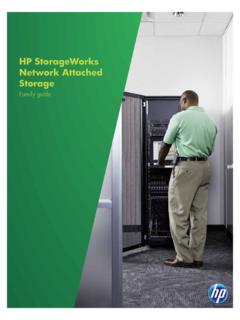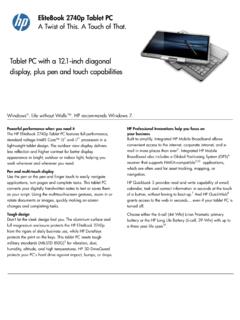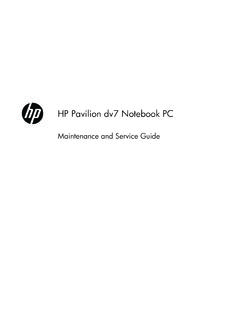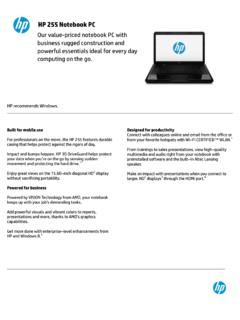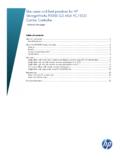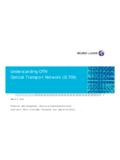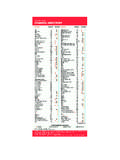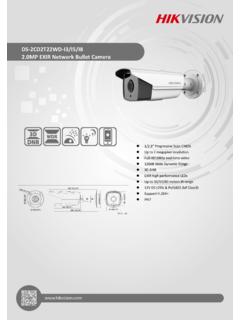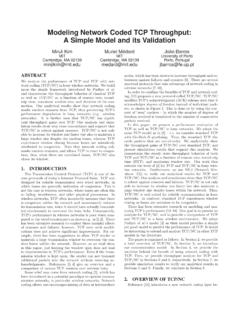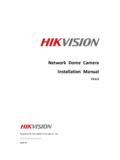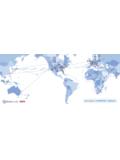Transcription of wireless USB network adapter - hp.com
1 Hp digital home networkingwireless USBnetwork adaptermodel hn210wwireless USB network adapter 2 acknowledgements and noticeshewlett-packard company noticesThe information contained in this document is subject to change without notice. Hewlett-Packard (HP) makes no warranty of any kind with regard to this material including, but not limited to, the implied warranties of merchantability and fitness for a particular purpose. Hewlett-Packard shall not be liable for any errors or for incidental or consequential damages in connection with the furnishing, performance, or use of this material. All rights reserved. Reproduction, adaptation, or translation of this material is prohibited without prior written permission of Hewlett-Packard, except as allowed under copyright , MS, MS-DOS, and Windows are registered trademarks of Microsoft following conventions are used in this guide:symbolsThe > symbol guides you through a series of software steps. For example:Click Start > Settings > Control Panel to view the active control Warning indicates possible damage to the HP Gateway or to other equipment.
2 A Warning can also indicate a possible harm to yourself or to example:Copyright 2001 Hewlett-Packard CompanyWarning: Plugging into a nongrounded electrical socket can damage your .. 5hp digital home networking wireless USB network adapter .. 5features .. 6getting to know the wireless USB network 7 LEDs .. 8 USB icon .. 9 USB cabling .. 10setting up a wireless 11wireless 13troubleshooting .. 18glossary .. 19index .. 29regulatory 31wireless USB network adapter 4 5introductionhp digital home networking wireless USB network adapterCongratulations on your purchase of the HP Digital Home Networking wireless USB network adapter . The wireless USB network adapter operates on the Industrial, Scientific, and Medical (ISM) band using Direct Sequence Spread Spectrum (DSSS) transmission to implement the IEEE standard being developed for the wireless industry. Users can now move easily between access points without having to reconfigure the wireless USB network adapter with its powerful built-in antenna gives you the freedom to work anywhere you want, letting you take full advantage of your PC and providing you with access to all your networked resources beyond your desktop.
3 LEDs provide feedback on power and adapter , which is compatible with Windows 98, Millennium, 2000, and XP, is a true necessity for all your wireless PC USB network adapter 6 featuresThe wireless USB network adapter is compatible with Windows 98, Millenium, 2000, and XP operating systems, and includes the following: Ghz frequency band, compliant with world standards wireless interface is compliant with the IEEE standard A Universal Serial Bus(USB) interface Capable of up to 128-bit Wired Equivalent Privacy (WEP) encryption Wire-free access to networked resources located anywhere beyond the desktop Move between access points without resetting the connection configuration Data transfer rate of up to 11 Mbps Direct Sequence Spread Spectrum (DSSS) Automatic fall-back rate User-friendly GUI setup software provides hassle-free configuration Free driver/firmware upgrades Built-in dialectric antenna with LEDs indicating Power and Link7getting to know the wireless USB network adapterportWireless USB network adapter USB portUSBC onnect the wireless USB network adapter to your computer through the Universal Serial Bus (USB)
4 Type B USB portwireless USB network adapter 8 LEDsWireless USB network adapter LEDsPowerLights green when the adapter is powered red when the adapter has an active connection. If the LED is not lit, the adapter is not interfacing with the icon9 USB iconThe USB icon identifies a USB iconwireless USB network adapter 10 USB cablingThe wireless USB network adapter comes with one USB cable. The cable has two plugs: Type A rectangular plug Type B square plugconnecting the cableFollow the steps below to connect the cable:1 Connect the Type B square plug to the wireless USB network adapter . 2 Connect the Type A rectangular plug to the USB port of your plugsUSB portsType AType BTypical USB ports on a computersetting up a wireless network11 setting up a wireless networknetwork topologyA wireless Local Area network (LAN) uses a wireless adapter to connect each computer to the network . Computers in a wireless network must be configured to share the same radio wireless USB network adapter provides wireless computers access to a wired network .
5 This integrated wireless and wired network is called an infrastructure configuration. A group of wireless - network - adapter -equipped computers plus a wireless access point, such as the HP wireless network Access Point, is called a Basic Service Set (BSS). The wireless access point connects the wireless network to the conventional wired network . Each wireless - network - adapter -equipped computer can communicate with any computer in a wired network infrastructure via the wireless access infrastructure configuration doubles the effective wireless transmission range of two wireless - network - adapter -equipped PCs since the wireless access point forwards data within the network . It is essential to use a unique ID, a BSSID or, more generically, an SSID within a wireless network . All PCs within an independent wireless network that are configured without roaming options (see Roaming below) must be configured with the same wireless network wireless network infrastructure configuration is appropriate for enterprise-scale wireless access to a central database and for mobile mode also supports roaming capabilities for mobile users.
6 A multiple wireless network can be configured as an extended wireless network , known as an Extended Service Set (ESS), allowing users to roam freely within it. All wireless - network - adapter -equipped PCs within one extended network must be configured with the same extended network ID an ESSID or taken generically with a BSSID as discussed above, called an SSID, and must use the same radio enabling an extended wireless network with roaming capability, select a feasible radio channel and an optimal location for the wireless access point. Proper wireless access point positioning and a clear radio signal will enhance USB network adapter 12 13wireless FAQsCan I run an application from a remote computer over the wireless network ?This depends on whether the application is designed to be used over a network . Consult the application s documentation to determine if it supports operation over a networkCan I play computer games with other members of the wireless network ?Yes, as long as the game supports multiple players over a local area network (LAN).
7 Refer to the game s documentation for more is the IEEE standard?The IEEE wireless LAN Standards Subcommittee of the Institute of Electrical and Electronics Engineers (IEEE) is formulating a standard for the industry to enable wireless LAN hardware from different manufacturers to communicate with one IEEE features are supported?HP wireless products support the following IEEE functions: CMSA/CA plus the Acknowledge protocol Multi-channel roaming Automatic rate selection RTS/CTS Fragmentation Power managementWould information be intercepted while transmitting on air? wireless LAN features two-fold security protection. On the hardware side, as with DSSS technology, it has the devices have the inherent scrambling security feature. On the software side, wireless LAN offers Wired Equivalent Privacy (WEP) encryption to enhance security and access USB network adapter 14 15troubleshootingMy computer does not recognize the wireless USB network adapter . Verify that the USB cable is properly connected to both the Type B USB adapter port and the Type A USB computer port.
8 Verify that the USB controller is enabled in the computer s BIOS. Check your computer s documentation for more wireless USB network adapter does not work properly. Reinsert the adapter s USB cable into the computer s USB port. Verify that the adapter is installed properly:1 Right-click My Computer. 2 Select Properties. 3 Select the Hardware tab, click Device Manager, and double-click network Adapters. If the adapter is installed properly, it will be displayed. If you see a yellow exclamation point, there may be a resource conflict. If so, do the following: Uninstall the drive software from your PC. Restart your PC. Repeat the adapter s software computer cannot communicate with computers linked via Ethernet to the wireless network in the infrastructure configuration. Verify that the computer you are trying to contact is powered on. Verify that your adapter is configured for the same channel, SSID, and WEP as the other computers in the infrastructure USB network adapter 16 17specificationsgeneralModel numberhn210wStandardsIEEE , USB , USB Type B portChannels11 channels ( , Canada)13 channels (Europe)14 channels (Japan)Operating range: indoorsup to 30 meters (100 ft) at up to 11 Mbpsup to 50 meters (165 ft) at up to Mbpsup to 70 meters (230 ft) at up to 2 Mbpsup to 91 meters (300 ft) at up to 1 MbpsOperating range.
9 Outdoorsup to 152 meters (500 ft) at up to 11 Mbpsup to 270 meters (885 ft) at up to Mbpsup to 396 meters (1,300 ft) at up to 2 Mbpsup to 457 meters (1,500 ft) at up to 1 MbpsData rateup to 11 Mbps (with automatic scale-back)LEDsPower, Linkwireless USB network adapter 18 environmentalDimensions123 mm x 86mm x 28mm( in x in x in)Power5V DC, 250mA Tx, 100mA Rx, 30mA standbyCertificationsFCC Part 15, Classes B and COperating temperature32 F to 104 F (0 C to 40 C)Storage temperature 13 F to 158 F ( 25 C to 70 C)Operating humidity10% to 70% noncondensingStorage humidity10% to 90% noncondensing19glossary10 BaseTEthernet standard topology for twisted pair (T) cabling (transfer rate of 10 Mbps over 100 meters).100 BaseTFast Ethernet twisted pair cabling (transfer rate of 100 Mbps over 100 meters).ad-hoc networkGroup of computers, each with a wireless LAN network adapter , connected as an independent wireless local area network for the duration of a single communications session.
10 An ad-hoc wireless LAN is applicable at a departmental scale for a branch or SOHO (small office/home office) (Asymmetric Digital Subscriber Line)A DSL modem technology geared to acceptable Internet performance in which downstream data transfer (downloading data from the Internet to the subscriber) is faster than upstream data transfer (uploading data from the subscriber).ATM (Asynchronous Transfer Mode) Asynchronous transfer mode (broadband switching). ATM (asynchronous transfer mode) a dedicated-connection switching technology that transmits digital data over a physical medium using digital signal technology. An individual cell is processed asynchronously relative to other related cells and is queued before being multiplexed over the transmission Internet access through DSL, cable modem, or other (Basic Service Set)One wireless (Basic Service Set Identification)A unique name (or ID) used by all computers on the network . A specific ad-hoc LAN. Computers in a BSS must be configured with the same topologySimple way of connecting computers in a network linearly along a single cable (each connected to the cable, not one to another).

